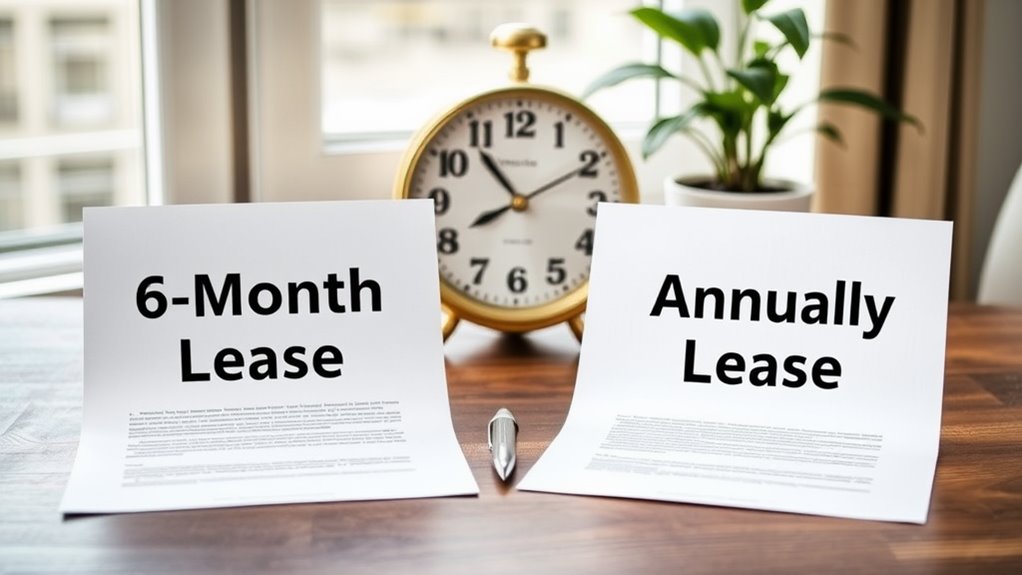When choosing between a 6-month or annual lease agreement, you’ll find 6-month terms offer flexibility, allowing frequent rent adjustments and tenant reassessments, but they may lead to higher turnover. Annual leases provide stability and predictability, reducing vacancy rates and turnover costs while ensuring steady income. Consider your financial goals and the local rental market to determine which term aligns with your property management strategy. Discovering further details can help refine your decision-making process.
Key Takeaways
- Identify all your options with our Lease Agreement Guide.
- 6-month leases offer flexibility, allowing tenants and landlords to reassess terms biannually.
- Annual leases provide stability, ensuring predictable rental income and lower tenant turnover.
- Shorter leases adapt quickly to market changes but increase turnover costs and vacancies.
- Longer leases reduce vacancy rates, fostering tenant commitment and minimizing management efforts.
- Choose lease terms based on financial goals, property demand, and desired flexibility.
Overview of 6-Month Lease Agreements
A 6-month lease agreement is a fixed-term rental contract that binds tenants to occupy a property for half a year. This arrangement provides stability for both landlords and tenants, as it guarantees the rental unit remains occupied for a defined period. Tenants benefit from the flexibility of a shorter commitment compared to annual leases, making it ideal for those in shifting living situations or uncertain about long-term housing needs. Landlords, on the other hand, reduce tenant turnover by avoiding the unpredictability of month-to-month agreements. The lease terms specify monthly rent payments, due dates, and other obligations, creating a clear framework for both parties. Using a long-term rental CRM can enhance tenant relationship management and streamline communication during the lease period. While a 6-month lease offers less long-term security than an annual agreement, it strikes a balance between flexibility and commitment. At the end of the term, landlords retain the option to adjust lease terms or terminate the rental agreement, providing further control over property management.
Overview of Annual Lease Agreements
Unlike shorter-term leases, an annual lease agreement establishes a binding contract for a full year, offering stability and predictability for both parties. Annual leases provide a fixed rental rate, shielding you from fluctuations in market conditions and ensuring consistent rental income for landlords. As a tenant, you gain security in tenant rights and living arrangements, while landlords benefit from reduced turnover. However, breaking an annual lease before its expiration may result in financial penalties or legal consequences. This lease term balances the advantages and disadvantages of a longer commitment, making it suitable for those seeking long-term housing solutions. Conducting a rental market analysis can provide insights into setting competitive and profitable rental rates.
| Aspect | Details |
|---|---|
| Duration | One-year commitment |
| Rent Structure | Fixed rental rate, unaffected by market changes |
| Tenant Benefits | Stability in housing and tenant rights for the lease term |
| Landlord Benefits | Predictable rental income and reduced turnover |
| Legal Implications | Penalties for early termination, enforcing binding lease agreement terms |
Flexibility in Lease Terms

Shorter-term leases, such as six-month or month-to-month agreements, provide adaptability for adjusting rental terms or responding to market changes, particularly in the context of seasonal fluctuations. In contrast, long-term annual leases offer stability with fixed rates and consistent tenancy commitments. You’ll weigh these factors based on your need for flexibility or predictability in your rental strategy.
Shorter-Term Adaptability
While a 6-month lease provides both landlords and tenants with increased flexibility, it enables landlords to revisit rental terms or pricing more frequently than annual agreements. You, as a landlord, can assess market conditions twice yearly, adjusting rental rates to align with current housing demand. This shorter lease agreement also offers adaptability for tenants, allowing them to relocate or change their housing situation with minimal commitment. For tenants with uncertain plans, such as job changes or lifestyle shifts, a 6-month lease provides a flexible solution. Additionally, you can use this shorter term as a trial period to evaluate tenant compatibility before committing to a longer agreement. The adaptability of a 6-month lease often attracts tenants seeking interim housing, potentially reducing vacancy periods and ensuring quicker occupancy rates.
Long-Term Stability
Long-term stability in lease agreements, particularly annual leases, provides landlords and tenants with predictable financial and living arrangements. Annual leases guarantee consistent rental income for landlords and reduce tenant turnover, minimizing vacancy-related costs and disruptions. Understanding tenant desires enhances rental property investments, ensuring lease terms align with market expectations. In contrast, a 6-month lease offers moderate stability but requires more frequent renegotiation, making it less predictable. While annual leases provide long-term stability, they limit flexibility to adapt to changing market conditions or tenant needs. Property modifications or rent adjustments become feasible only at renewal. A 6-month lease allows for quicker reassessment of market trends, offering greater adaptability. Both lease agreements require balancing stability with flexibility, assuring landlords secure reliable rental income while tenants maintain living arrangements aligned with their circumstances. Careful consideration of tenant needs and market fluctuations is essential when choosing between these terms.
Stability and Predictability
An annual lease provides long-term income assurance by securing consistent cash flow and reducing financial uncertainty. You’ll experience lower tenant turnover rates, minimizing disruptions and vacancy periods. This predictability facilitates effective financial planning and operational efficiency for your property. Additionally, the stability of an annual lease aligns well with strategic planning for long-term wealth accumulation through real estate investments.
Long-Term Income Assurance
Annual leases provide landlords with a stable and predictable rental income, ensuring reliable cash flow for financial planning. By securing a longer lease term, you minimize tenant turnover, reducing the frequency and costs of finding new renters. This stability allows you to anticipate turnover dates, streamlining property management and marketing efforts. The commitment of tenants in an annual lease fosters consistency, which often leads to better property care and fewer maintenance expenses. Unlike a monthly lease, an annual agreement mitigates risks associated with frequent vacancies, enhancing long-term income assurance. You can confidently cover mortgage payments, property maintenance, and other expenses throughout the lease term. Leveraging Property Management Software can further enhance efficiency in handling tenant agreements and financial tracking. Overall, an annual lease offers a structured approach to sustaining stable rental income, supporting your financial planning and securing your property’s value over time.
Lower Tenant Turnover Rates
Lower tenant turnover rates provide landlords with increased stability and predictability in rental income. By offering fixed-term leases, such as a one-year residential lease, you considerably reduce tenant turnover compared to month-to-month leases. Studies show properties with annual leases experience up to 30% lower turnover rates. This stability minimizes vacancies, decreases property management efforts, and guarantees a steady rental market presence. Long-term leases also foster tenant commitment, enhancing your property’s reputation and attracting quality applicants. With lower turnover rates, you avoid frequent tenant searches and associated costs, reinforcing predictable income. Reports based on thorough data and marketing analysis highlight the benefits of long-term leasing strategies.
| Lease Type | Tenant Turnover Rate |
|---|---|
| Fixed-Term Lease | Up to 30% lower |
| Month-to-Month Lease | Higher volatility |
Opting for annual leases strengthens your property management strategy while guaranteeing long-term financial reliability.
Financial Planning Ease
Because a 1-year lease guarantees consistent rental income, you’ll benefit from stable cash flow that simplifies budgeting and financial planning for property-related costs. The predictability of a one-year term allows you to anticipate changes, such as tenant move-outs, and allocate resources for marketing or maintenance without financial strain. With stable rental income, you avoid the recurring costs and effort required to find new tenants frequently. Additionally, locking in rent for an extended period shields you from potential market fluctuations, ensuring predictable revenue. This long-term commitment minimizes turnover, reducing expenses tied to vacancy periods and tenant changes. By maintaining a steady income stream, you can focus on property upkeep and strategic improvements, further enhancing your financial planning and overall stability as a landlord. Market analysis helps landlords stay competitive by understanding local rental rates and making informed decisions.
Tenant Turnover and Vacancy Rates

Tenant turnover rates can markedly impact a property’s vacancy and operational costs, with annual leases typically averaging a 45% turnover rate compared to month-to-month agreements, which often exceed 60%. This disparity directly affects vacancy rates, as month-to-month leases tend to experience longer vacancies—averaging 30 days—versus 15 days for annual leases. High rental demand areas show lower vacancy rates for annual leases (5-10%) compared to month-to-month leases (15-20%). Turnover costs also rise with shorter lease durations, averaging $2,500 for month-to-month agreements versus $1,000 for annual leases. Stability in occupancy rates is another advantage of annual leases, which consistently maintain rates above 90%, unlike month-to-month leases, which fluctuate with tenant mobility.
| Lease Type | Average Turnover Rate | Vacancy Duration |
|---|---|---|
| Annual Leases | 45% | 15 days |
| Month-to-Month Leases | 60%+ | 30 days |
Financial Implications for Landlords for 6-Month or Annual Lease
The financial impact of lease duration on landlords is a key consideration in property management. With a shorter lease, income may be less stable due to frequent tenant turnover, though it allows for quicker rental rate adjustments. Tenants can move out with shorter notice periods, which can disrupt financial planning. Conversely, an annual lease provides a steady rental income, aiding in budgeting and covering fixed expenses with certainty. However, you sacrifice the flexibility to adjust rental rates as market conditions change. Property is whether you prioritize stability or adaptability when deciding lease terms. Shorter leases entail higher turnover costs, including advertising and tenant recruitment, while annual leases reduce these expenses but may limit income potential. Weigh the pros and cons to make an informed decision based on your financial goals and property management strategy.
Conclusion
When weighing 6-month versus annual leases, you’ll find shorter terms offer fluidity for adaptability, while longer agreements provide a steady anchor for consistency. Consider tenant movement and the financial ebb and flow inherent in each option. Ultimately, your choice will hinge on balancing the dance of flexibility with the bedrock of stability, ensuring both your interests and those of your tenants remain harmoniously aligned in a mutually beneficial arrangement.




